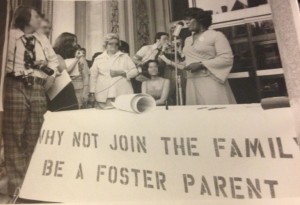Faith, family and community. These are what mattered most to FAFS’ founder Bernie Dondiego, who passed away on July 7, 2015.
To read our full tribute to Bernie, visit our website.

Faith, family and community. These are what mattered most to FAFS’ founder Bernie Dondiego, who passed away on July 7, 2015.
To read our full tribute to Bernie, visit our website.
A message from FAFS’ CEO Mary Jane Awrachow :
There are three words that signify what the 40th Anniversary of Foster and Adoptive Family Services has meant to us.
The first word is celebration.
 This anniversary was a celebration of how FAFS has grown during our 40 years. From our humble beginnings, when Hattie Talley and Sue and Bernie Dondiego sat around a kitchen table in 1972 to the fully staffed robust and active organization we are today, we’ve expanded our services to cover the needs of foster, adoptive and kinship parents. Continue reading
This anniversary was a celebration of how FAFS has grown during our 40 years. From our humble beginnings, when Hattie Talley and Sue and Bernie Dondiego sat around a kitchen table in 1972 to the fully staffed robust and active organization we are today, we’ve expanded our services to cover the needs of foster, adoptive and kinship parents. Continue reading
 FAFS was headquartered in Trenton throughout the 1980s before returning to its permanent home in Middlesex County in 1994. Sue Dondiego, one of FAFS’ founders noted, “From its humble beginnings as an all volunteer organization to the present day, FAFS has focused their time, talents and hard work to develop programs, projects and activities that would improve the lives of resource parents and the children in their care.” What started with just a handful of people in 1974 has developed into an organization of many people with the talents and backgrounds that form the thriving group FAFS is today. Continue reading
FAFS was headquartered in Trenton throughout the 1980s before returning to its permanent home in Middlesex County in 1994. Sue Dondiego, one of FAFS’ founders noted, “From its humble beginnings as an all volunteer organization to the present day, FAFS has focused their time, talents and hard work to develop programs, projects and activities that would improve the lives of resource parents and the children in their care.” What started with just a handful of people in 1974 has developed into an organization of many people with the talents and backgrounds that form the thriving group FAFS is today. Continue reading
 We have a story we like to tell here at Foster and Adoptive Family Services.
We have a story we like to tell here at Foster and Adoptive Family Services.
It involves our co-founder Sue Dondiego. She was standing before the Legislature at the State House in Trenton in the 1970s to fight for increased resource family rates. At the time, the monthly clothing allowance for a child in foster care was about equal to one-third of the price of a new children’s coat. Continue reading
 Foster care’s primary mission – providing a suitable home environment for children in need – has stood the test of time, but many other aspects of foster care in the US have evolved substantially since its inception in our early history. Some of the most dramatic differences between past and present lie in the reasons children enter foster care.
Foster care’s primary mission – providing a suitable home environment for children in need – has stood the test of time, but many other aspects of foster care in the US have evolved substantially since its inception in our early history. Some of the most dramatic differences between past and present lie in the reasons children enter foster care.
In the past, foster care was primarily intended to serve children who had lost their families or whose families were financially or materially unable to provide for them. According to many first-hand accounts, children were most likely to remain in foster care temporarily while their biological parents sought better wages and improved living conditions. If we fast forward to the present, however, we find that that’s no longer the case. Continue reading